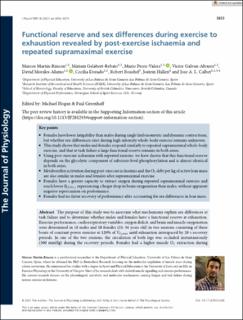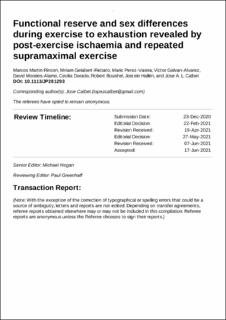| dc.description.abstract | The purpose of this study was to ascertain what mechanisms explain sex differences at task failure and to determine whether males and females have a functional reserve at exhaustion. Exercise performance, cardiorespiratory variables, oxygen deficit, and brain and muscle oxygenation were determined in 18 males and 18 females (21–36 years old) in two sessions consisting of three bouts of constant-power exercise at 120% of VO2max until exhaustion interspaced by 20 s recovery periods. In one of the two sessions, the circulation of both legs was occluded instantaneously (300 mmHg) during the recovery periods. Females had a higher muscle O2 extraction during fatiguing supramaximal exercise than males. Metaboreflex activation, and lean mass-adjusted O2 deficit and debt were similar in males and females. Compared to males, females reached lower PETCO2 and brain oxygenation during supramaximal exercise, without apparent negative consequences on performance. After the occlusions, males and females were able to restart exercising at 120% of VO2max, revealing a similar functional reserve, which depends on glycolytic component of substrate-level phosphorylation and its rate of utilization. After ischaemia, muscle O2 extraction was increased, and muscle was similarly reduced in males and females. The physiological response to repeated supramaximal exercise to exhaustion is remarkably similar in males and females when differences in lean mass are considered. Both sexes fatigue with a large functional reserve, which depends on the glycolytic energy supply, yet females have higher oxygen extraction capacity, but reduced PETCO2 and brain oxygenation.
Key points
• Females have lower fatigability than males during single limb isometric and dynamic contractions, but whether sex-differences exist during high-intensity whole-body exercise remains unknown.
• This study shows that males and females respond similarly to repeated supramaximal whole-body exercise, and that at task failure a large functional reserve remains in both sexes.
• Using post-exercise ischaemia with repeated exercise, we have shown that this functional reserve depends on the glycolytic component of substrate-level phosphorylation and is almost identical in both sexes.
• Metaboreflex activation during post-exercise ischaemia and the O2 debt per kg of active lean mass are also similar in males and females after supramaximal exercise.
• Females have a greater capacity to extract oxygen during repeated supramaximal exercise and reach lower PETCO2, experiencing a larger drop in brain oxygenation than males, without apparent negative repercussion on performance.
• Females had no faster recovery of performance after accounting for sex differences in lean mass. | en_US |

